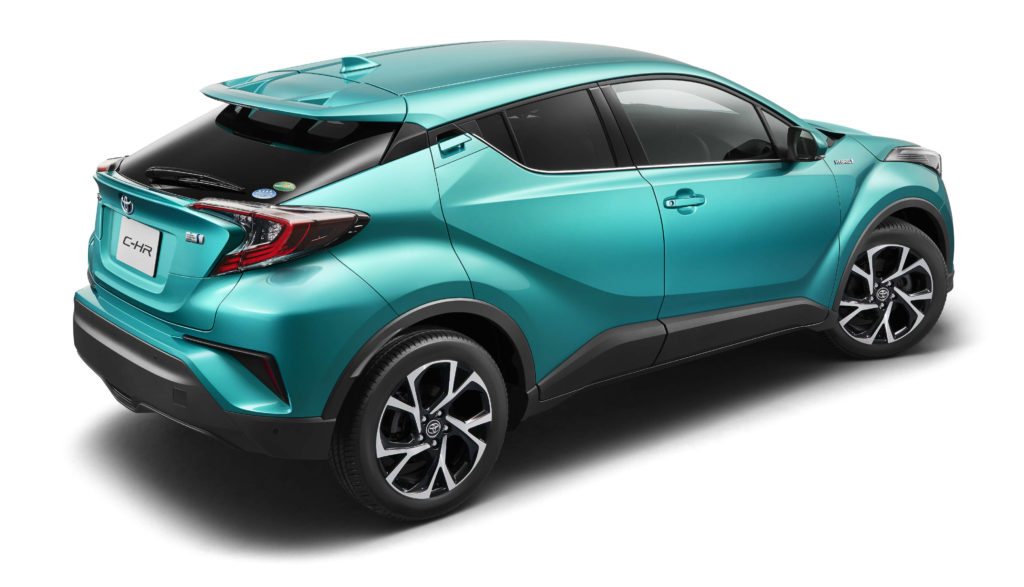 Toyota Motor Corporation has unveiled an overview of the Japanese domestic market specifications of its new C-HR, or Coupe High-Rider. Toyota has started accepting advance orders online, and the nationwide market launch will follow at the end of 2016.
Toyota Motor Corporation has unveiled an overview of the Japanese domestic market specifications of its new C-HR, or Coupe High-Rider. Toyota has started accepting advance orders online, and the nationwide market launch will follow at the end of 2016.
Through its distinctive styling, driving performance and other sellable features, Toyota hopes to increase the demand for the C-HR from a wider range of customers within the growing compact crossover market. The newcomer is targeted mainly at information-savvy customers, including those in their 20s and 30s. With its powerful suspension and eye-catching design, the C-HR is an expression of a new genre – a crossover with the feel of a coupe.
Under the concept of “Sensual Speed-Cross”, the design of the C-HR features a diamond architectural theme, with eye-catching details that have been sculpted and chamfered to represent the faceted surfaces of a precision-cut gemstone. Viewed from any angle, the elegantly integrated detailing creates a delicate balance of precision and sensuality.
The C-HR’s coupe-like styling is further enhanced by disguised rear door handles integrated within the C-pillars. Sequential turn signals, in which 12 LEDs light up sequentially from the inside to the outside, had been adopted for the first time in a Toyota-brand vehicle.
The driving concept behind the C-HR is that of responsive performance. With further refinements to the TNGA platform, the vehicle has improved chassis rigidity, handling stability and comfort. Furthermore, the driving performance has been thoroughly enhanced with repeated driving tests that have been conducted on varying types of roads throughout the world, including Europe and Japan.
The front uses newly developed MacPherson struts while the rear uses double-wishbone suspension. Furthermore, the use of large-diameter stabilisers and optimisation of the damping characteristics of the dampers help to provide superior steering stability and a comfortable ride. Sachs shock absorbers are offered as standard equipment. In addition, urethane material had been adopted for the cushioning in the upper support for the first time by Toyota.
The standard S and S-T grades, and the more fully featured G and G-T grades are available in both 1.8-litre hybrid and 1.2-litre turbo engine versions.
All models come with Toyota Safety Sense P, a collision avoidance assist package that includes a Pre-collision System, a pedestrian detection function, radar cruise control featuring all-speed tracking, Lane Departure Alert (with steering control) and Automatic High Beam (AHB).
Based on the “Sensual Tech” design concept, the interior produces an unprecedented advanced feel. Soft pads leading from the instrument panel to the door trimmings and metallic-tone ornaments expresses an expansive space. The control panel, with various meters situated in the center, is positioned facing the driver, with all items laid out along a continuous line, allowing all driving operations to be carried out smoothly.
The twin-lens, cylindrical-type meter with radiating blue lines on its face expresses depth and innovation. The multi-information display (4.2-inch color TFT) provides information at high resolution. The sporty seats offer excellent support, with optimised seat pad thickness that evenly distributes the pressure across the ischial bones and makes long rides more comfortable.
The C-HR offers ample cabin space with a length of 1715mm and a width of 1455mm, while keeping the overall height at 1550mm (1565mm for the turbo 1.2-litre version), which can easily manoeuvre within multi-storey parking structures. Slimm A-pillars and well-positioned side mirrors help to ensure excellent visibility for the driver.
Eight exterior colours are available for the C-HR, including the newly developed Radiant Green Metallic and Metal Stream Metallic. Black and licorice brown are available as interior colour schemes. 
Related Articles














